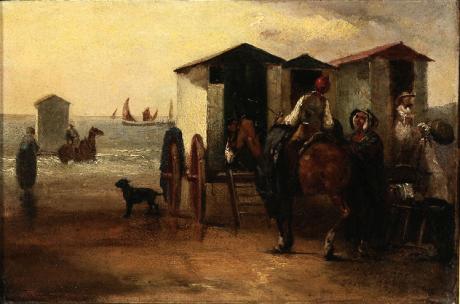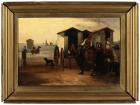The bathing machine was a device, popular in the 18th and 19th centuries, to allow people to change out of their usual clothes, possibly change into swimwear and then wade in the ocean at beaches. Bathing machines were roofed and walled wooden carts rolled into the sea. Some had solid wooden walls; others had canvas walls over a wooden frame. The bathing machine was part of sea-bathing etiquette more rigorously enforced upon women than men but to be observed by both sexes among those who wished to be "proper".Especially in Britain, men and women were usually segregated, so nobody of the opposite sex might catch sight of them in their bathing suits, which (although modest by modern standards) were not considered proper clothing in which to be seen. According to some sources, the bathing machine was developed about 1750 by Benjamin Beale at Margate, Kent. Other sources say they did not come into common use until decades later. In Scarborough Public Library there is an engraving by John Setterington dated 1736 which shows people bathing and popularly believed to be first evidence for bathing machines, however Devon claims this a year earlier in 1735.Bathing machines were most common in the United Kingdom and parts of the British Empire with a British population, but were also used in France, Germany, the United States, Mexico, and other nations. Legal segregation of bathing areas in Britain ended in 1901, and the bathing machine declined rapidly. By the start of the 1920s bathing machines were almost extinct, even on beaches catering to an older clientele.The bathing machines remained in active use on English beaches until the 1890s, when they began to be parked on the beach. They were then used as stationary changing rooms for a number of years. Most of them had disappeared in the United Kingdom by 1914. However, they have survived to this day as bathing boxes in many parts around the world. In this painting the costumes are French and the bathing machines were introduced to France in the English fashion by the Duchess de Berry at Dieppe around 1822.
Gudin was part of the circle of artists of Richard Parkes Bonnington who painted in the Dieppe area. Gudin abandoned his studies to enter the studio of Girodet-Trioson . It debuted at the Paris Salon of 1822 with a Brick in distress and a view of the mouth of the Seine. In 1824 , he exhibited a Rescue and a view of Fort Chaput near the island of Oleron. It was at this time already a protégé of the Duke of Orleans who became king of the French under the name of Louis-Philippe I.. He had executed a painting of the visit by a privateer of America, the ship on which the Duke had embarked for the United States in 1796 . This table is presented at the show in 1827 with the Steamboat landing its passengers at Dover . He is vice president of the young Central Society of Humane since its inception in 1864, his brother who disappeared in 1855 in the wreck of The Semillante. Charles X commissioned Death of Ensign Bisson in 1828. Gudin's friend Dupetit-Thouars and takes part in the expedition to Algiers , where he drew many sketches. He was appointed painter to the Royal Navy. He made a tour of Italy, then to Switzerland in 1832, making numerous sketches in his notebooks: September 3, 1832 it is on the border between Piedmont and Switzerland, 12 September 1832 he is at Sion where he sketched the hills of Valere and Tourbillon; May 24 the following year, he resides in Moudon and May 26 in Thun, two cities where he made ??sketches of remarkable historical sites. He then traveled to Russia where he made ??sketches of Russian naval maneuvers. He returned to France on "Danae". Under Louis-Philippe , he was named Baron. The king commissioned 90 paintings for the museum of Versailles: they should commemorate the events of the French naval history. He is an Officer of the Legion of Honor in 1841 .In 1844 he married the daughter of a lord, god-daughter of Louis Philippe. When the revolution of 1848 arrives, he divides his time between France and England and has good relations with all political powers! However, during the coup of 1852, Gudin is on the Republican side. He rose to the distinction of Commander in 1857 . A few years later, Gudin accompanies the Emperor Napoleon III in Algeria , then returned to Tangier on "Queen Hortense." In 1870, Gudin resides in England. It falls gently into oblivion only because of its student Morel-Fatio be permanently known. His daughter Henriette Gudin was also a painter. Among his pupils was Louis-Laurent Atthalin .


